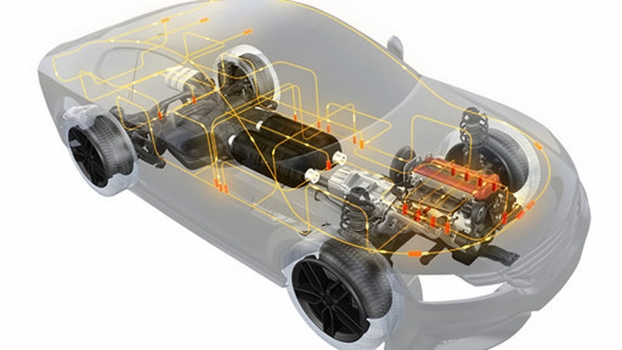
Plastics are a great enabler. They make many products better, lighter, more attractive, safer, quieter and more durable. In no sector is that truer than in electrical and electronics (E&E).
In such applications, plastics can offer insulation, electrical and mechanical resistance, energy efficiency, flammability protection, design freedom, and recyclability – in products ranging from circuit boards, cables, televisions, laptops and cell phones to small appliances, lighting, tools and office equipment. The list is endless.
Ascend PA66 – lighting
Some lighting components, like the connectors and bobbins shown here, are made from polyamide –– in this case Vydyne® PA66 from Ascend Performance Materials
Ineos Styrolution – office equipment
Styrenic resins, such as those offered by Ineos Styrolution, find use in a diverse range of consumer electronics and office equipment, including laptops, phones, monitors, printers, cameras and the like.
These resins help product developers and designers to miniaturize the form factors of many popular consumer electronics, while contributing to key features such as effective heat management and stylish design.
Some of these same features explain why such polymers will also play a vital role in the infrastructure needed to enable 5G, the emerging fifth generation of high-speed, wireless technology that will reshape entire industries.
Materials suppliers offer multiple grades of high-performance resins and compounds to serve the vast and diverse E&E sector. Flame-retardant polyamide (PA) materials, for example, find extensive use in such applications as electrical housings, enclosures, sockets, switches and wiring components.
BASF plug connectors
BASF offers highly specialized, flame-retardant grades of Ultramid® polyamide that are ideal for electrical insulating applications (such as plug connectors, sensors, actuators, etc.) in home appliances and similar products.
DSM wire & cable
DSM notes that its Arnitel® thermoplastic copolyester offers reliable high temperature resistance, which helps make it ideal for wire and cable jacketing.
One major supplier, DuPont, notes how PBT thermoplastic polyester resins can be extensively modified to tailor them for E&E applications, including flame-retardant, glass-reinforced and hydrolysis-resistant versions. And it points out how acetal resin can bridge the performance gap between metal and plastics.
DSM continues to expand its family of high-temperature PA materials, targeting them specifically for electronic connectors in automotive applications that will not blister during high-temperature soldering processes.
DSM – EMI shielding in cars
DSM says it developed some of its high-temperature ForTii® Ace polyamide materials specifically for use in electronic connectors in automotive applications, such as those highlighted here.
SABIC and Covestro are among those offering a wide range of polycarbonate (PC) resins that can offer glass-like transparency and aesthetics, moisture blocking and even electrical conductivity, if desired, in a host of E&E applications.
PC also will play a key role in the infrastructure for the new 5G wireless networks being developed. 5G delivers much faster mobile data speeds – up to 10 gigabytes per second, or potentially up to 10 times quicker than today’s 4G speeds – opening up whole new vistas in such areas as streaming entertainment, smart cities, autonomous mobility, factory automation, and machine/device communication (thereby benefiting implementation of the Industrial Internet of Things).
But 5G uses something called millimeter wave (or mmWave) signals which, unlike current 4G signals, tend to max out at a few hundred meters, and can’t go around corners or through walls.
This means that providers need to build an entirely new infrastructure to enable point-to-point signal transmission. Estimates suggest that anywhere from 10 to 100 times the current number of base stations will be needed for 5G than currently exist.
Hardware suppliers such as Samsung, Ericsson, Huawei and Nokia are investing billions of dollars into building the base stations and transmitters that will be needed to realize the full potential of this emerging technology.
This is creating a huge opportunity for advanced plastic materials such as polycarbonate. Those base stations and transmitters that are located outside in the elements need to exhibit excellent durability and weather resistance, in a wide range of hot and cold temperatures. And those located inside homes and office buildings also need to be aesthetically pleasing. All of them will need to have transmitter covers that are permeable to radio frequency signals, to minimize material interference – a feature offered by polycarbonate.
Covestro 5G bird antenna
Covestro, Deutsche Telekom and the Swedish Umeå Institute of Design partnered on a pilot project to test out creative designs for small 5G antennae. One concept was this stylistic “bird,” made with Makrolon® polycarbonate, perched on a street lamp.
Plastics also are finding use as materials for the 3D printing of complex components that can be used in E&E applications.
So, it is clear that the rise of beautifully designed, high-powered electronics and lightning-fast wireless technologies simply would not be possible without today’s advanced plastic materials.
Don’t miss the chance to learn about these, and so much more, at CHINAPLAS 2020 in Shanghai next April 21-24. For more information about CHINAPLAS 2020, please visit the official show website at www.ChinaplasOnline.com











More Stories
What You Should Know Before Filing a Car Accident Claim
Injured in a Car Accident in St. Louis? Here’s What to Do Next
Historic Sportscar Racing (HSR) and Goodyear Announce Multi-Year Partnership